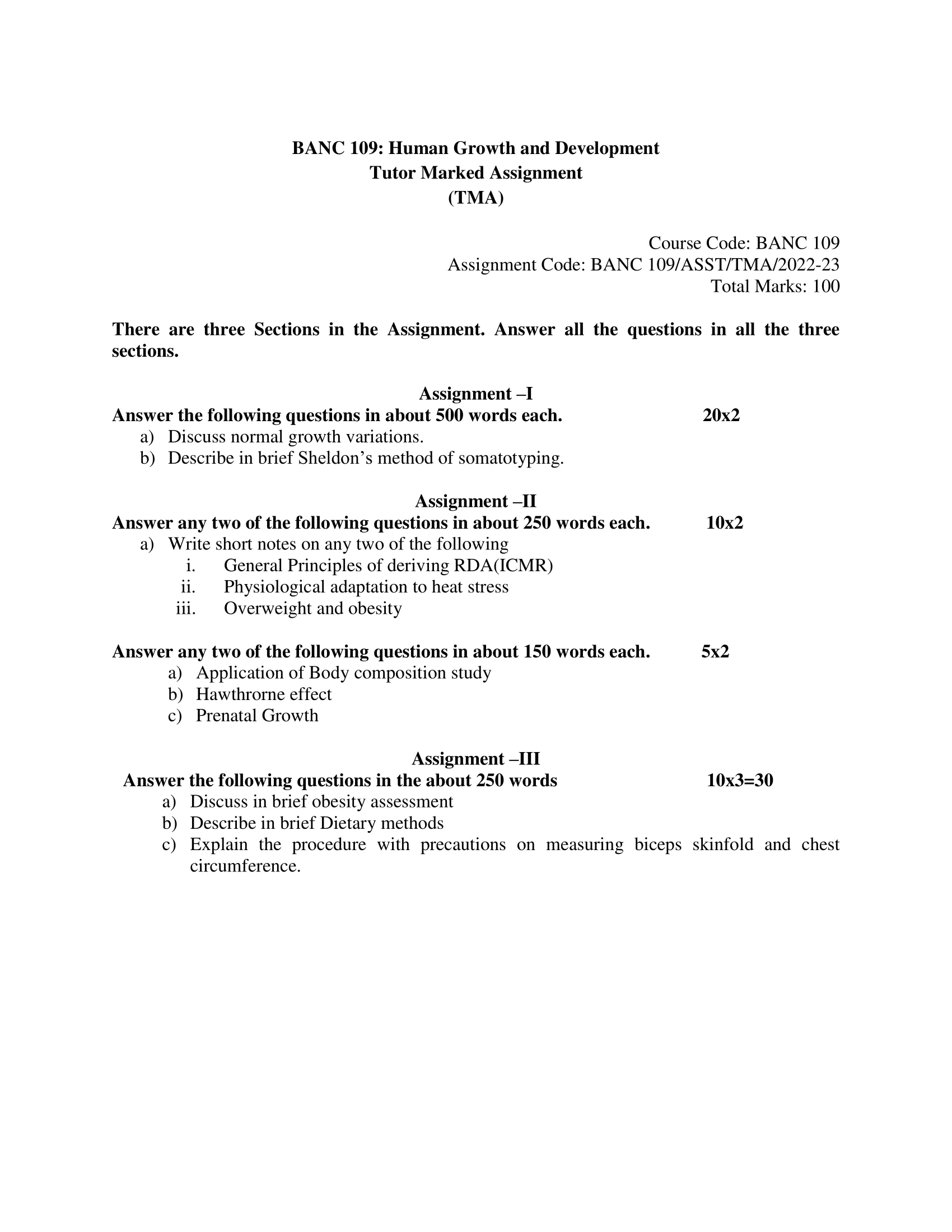
| Title | BANC-109: IGNOU BAG Solved Assignment 2022-2023 |
| University | IGNOU |
| Degree | Bachelor Degree Programme |
| Course Code | BANC-109 |
| Course Name | Human Growth and Development |
| Programme Name | Bachelor of Arts (General) |
| Programme Code | BAG |
| Total Marks | 100 |
| Year | 2022-2023 |
| Language | English |
| Assignment Code | BANC 109/ASST/TMA/2022-23 |
| Last Date for Submission of Assignment: | For June Examination: 31st April For December Examination: 30th September |

Assignment –I
Answer the following questions in about 500 words each. 20×2
a) Discuss normal growth variations.
Ans: Normal growth variations refer to the differences in physical growth patterns among individuals in a population that are within the range of normal growth and development. This includes variations in height, weight, and body composition, as well as the timing of growth milestones such as puberty and the onset of menstruation.
There are several factors that contribute to normal growth variations. Genetics play a significant role in determining an individual’s growth potential, with height being a particularly heritable trait. Environmental factors, such as nutrition, physical activity, and stress, can also impact growth. For example, malnutrition and poor health can slow growth, while a balanced diet and regular exercise can promote healthy growth.
Puberty is another important factor in normal growth variations. This period of rapid growth and development is influenced by hormones and genetics, and typically occurs between the ages of 9 and 16 for girls and 10 and 16 for boys. During puberty, individuals experience physical changes such as an increase in height, the development of secondary sexual characteristics, and the onset of menstruation for girls. The timing of puberty can vary widely among individuals and can be influenced by factors such as genetics, diet, and stress levels.
It is important to note that normal growth variations do not include growth patterns that are outside the range of normal development, such as growth disorders such as dwarfism or gigantism. These conditions are caused by underlying medical conditions or genetic factors and typically require medical intervention.
b) Describe in brief Sheldon’s method of somatotyping.
Ans: Sheldon’s method of somatotyping is a system for classifying and describing an individual’s body type based on their physical characteristics. Developed by psychologist William H. Sheldon in the 1940s, Sheldon’s somatotyping categorizes individuals into three distinct body types: endomorphs, mesomorphs, and ectomorphs.
Endomorphs are characterized by a rounded, soft, and heavy build with a tendency towards higher levels of body fat. They have a larger bone structure, a wider waist, and are typically slower to gain muscle mass.
Mesomorphs are characterized by a well-defined, muscular build with a balanced combination of muscle mass and body fat. They have a medium bone structure, a well-defined waist, and are typically more athletic in appearance.
Ectomorphs are characterized by a lean, slender build with a low level of body fat and a tendency to have difficulty gaining weight. They have a smaller bone structure, a narrow waist, and are typically taller and thinner in appearance.
Sheldon’s somatotyping has been widely used in various fields, including psychology, sports science, and fitness, as a means of understanding individual differences in physical characteristics and their potential impact on health and athletic performance. However, it is important to note that Sheldon’s method of somatotyping has been criticized for oversimplifying the complexity of human physique and body composition, and has been largely replaced by more sophisticated and evidence-based methods of body composition analysis.
Assignment –II
Answer any two of the following questions in about 250 words each. 10×2
a) Write short notes on any two of the following:
i. General Principles of deriving RDA(ICMR)
Ans: General Principles of deriving RDA(ICMR):
The Recommended Dietary Allowances (RDAs) are set by the Indian Council of Medical Research (ICMR) and provide the daily nutrient requirements for individuals in India. The RDAs are based on several general principles, including:
- Adequacy: RDAs are set to ensure that the daily nutrient intake of a majority of individuals meets their nutritional needs for health and well-being.
- Individual variation: RDAs take into account the variability in nutrient needs among individuals based on factors such as age, gender, body size, and level of physical activity.
- Margin of safety: RDAs are set to provide a margin of safety to ensure that the nutrient requirements of almost all individuals are met, even under conditions of increased stress or increased physiological demands.
- Evidence-based approach: The RDAs are based on the best available scientific evidence and are regularly reviewed and updated as new research becomes available.
- Balance of nutrients: The RDAs consider the balance of nutrients required for optimal health and well-being and take into account the interactions between nutrients.
These general principles ensure that the RDAs provide a comprehensive and evidence-based approach to determining daily nutrient requirements for individuals in India. The RDAs serve as a valuable resource for individuals, healthcare professionals, and policy makers in ensuring that the population has access to adequate and balanced nutrition.
ii. Physiological adaptation to heat stress
Ans: Physiological adaptation to heat stress:
Heat stress is a condition that occurs when the body is unable to dissipate heat effectively and maintain a normal internal temperature. This can lead to dehydration, heat exhaustion, and even heat stroke in severe cases. The human body has several physiological adaptations that help to cope with heat stress and prevent these health problems. Some of these adaptations are:
- Sweating: The primary mechanism for dissipating heat in the body is through sweating. When the body is exposed to heat, the hypothalamus stimulates the sweat glands to produce sweat, which then evaporates and cools the skin.
- Vasodilation: To help dissipate heat, the blood vessels in the skin dilate, increasing blood flow to the skin and promoting heat loss through sweating.
- Reduced physical activity: During heat stress, the body naturally reduces physical activity to conserve energy and prevent further heat production.
- Increased fluid intake: To prevent dehydration, it is important to increase fluid intake during heat stress. The body naturally stimulates thirst as a way to prompt individuals to drink more fluids.
- Acclimatization: With repeated exposure to heat, the body can adapt and become more efficient at dissipating heat. This process is known as acclimatization and can take several days to several weeks.
These physiological adaptations help the body to cope with heat stress and prevent the development of heat-related health problems. It is important to take measures to prevent heat stress, such as wearing light-colored clothing, staying in air-conditioned environments, and drinking plenty of fluids.
iii. Overweight and obesity
Ans: Overweight and obesity:
Overweight and obesity are conditions characterized by an excessive accumulation of body fat, which can lead to a range of health problems. Overweight is defined as having a body mass index (BMI) of 25-29.9, while obesity is defined as having a BMI of 30 or higher.
The causes of overweight and obesity are complex and multi-factorial, including genetic, environmental, and lifestyle factors. The increasing availability of high-calorie foods, a sedentary lifestyle, and reduced physical activity are major contributors to the current obesity epidemic.
Overweight and obesity can lead to a range of health problems, including cardiovascular disease, type 2 diabetes, sleep apnea, and certain types of cancer. In addition, being overweight or obese can also have a significant impact on an individual’s quality of life, including decreased mobility, reduced self-esteem, and depression.
Treatment for overweight and obesity typically involves a combination of dietary changes, increased physical activity, and behavior modification. In some cases, pharmacotherapy or bariatric surgery may be recommended for those who are severely obese.
Prevention of overweight and obesity is an important public health priority and involves promoting healthy diets and physical activity, creating supportive environments for healthy behaviors, and reducing exposure to obesogenic factors such as unhealthy food marketing.
Answer any two of the following questions in about 150 words each. 5×2
a) Application of Body composition study
Ans: Application of Body Composition Study:
Body composition study refers to the measurement and analysis of the different components of an individual’s body, including lean mass (muscles, bones, and organs), fat mass, and bone mineral content. The application of body composition study is wide-ranging and includes the following areas:
- Sports and Exercise Science: Body composition is an important aspect of athletic performance and can impact an athlete’s power, speed, and endurance. Body composition analysis can help coaches and trainers optimize training programs and monitor changes in body composition over time.
- Clinical Medicine: Body composition analysis is used in clinical medicine to diagnose and monitor obesity and other conditions that impact body weight, such as eating disorders and muscle wasting diseases.
- Public Health: Body composition analysis can help public health researchers understand the impact of obesity and related health conditions on population health.
- Nutritional Science: Body composition analysis can help nutritional scientists understand the impact of dietary changes and supplements on body composition and overall health.
Overall, body composition analysis provides valuable information about an individual’s health and fitness and can inform a wide range of decisions related to health, wellness, and athletic performance.
b) Hawthrorne effect
Ans: The Hawthorne effect refers to the phenomenon in which individuals change their behavior in response to being observed or studied. The effect is named after a series of experiments conducted at the Hawthorne Works factory in the 1920s and 1930s, which investigated the impact of workplace lighting on productivity. The experiments found that productivity increased not only when lighting was improved but also when other working conditions were altered, suggesting that the mere act of being observed was enough to change the workers’ behavior.
The Hawthorne effect has since been documented in many other studies, particularly in the field of organizational behavior, where researchers have found that employees may alter their behavior in response to being observed as part of a study or intervention. This can impact the validity of the study results and limit the ability to generalize the findings to other settings.
To minimize the impact of the Hawthorne effect, researchers typically use control groups and random assignment to ensure that any changes observed are a result of the intervention being studied, rather than the act of being observed. Additionally, some researchers choose to conduct studies in naturalistic settings where participants are not aware they are being observed, or use unobtrusive measures to minimize the impact of the Hawthorne effect.
c) Prenatal Growth
Ans: Prenatal growth refers to the growth and development of a fetus during pregnancy. The prenatal period begins at conception and continues until birth, and is a critical time in the development of an individual, as the fetus undergoes a number of important changes in size, structure, and function.
The rate of prenatal growth varies depending on various factors such as the mother’s health and nutrition, the presence of any complications during pregnancy, and the fetus’s genetic makeup. During the first trimester, the fetus grows rapidly, with the majority of its organs and systems developing and maturing. During the second trimester, the fetus continues to grow, and movement and coordination begin to develop. In the third trimester, the fetus experiences a rapid growth spurt and puts on weight in preparation for birth.
Measuring prenatal growth is an important aspect of prenatal care, and helps healthcare providers monitor the health and development of the fetus. This can be done through ultrasound, which measures the size of the fetus, or through measuring the height of the uterus and the size of the fetus by feeling the uterus through the abdominal wall.
Adequate prenatal growth is important for the health and development of the fetus, and can impact future health and well-being. Factors such as poor nutrition, exposure to toxins, and maternal stress can all impact prenatal growth and development, and may result in low birth weight or other complications.
Assignment –III
Answer the following questions in the about 250 words 10×3=30
a) Discuss in brief obesity assessment
Ans: Obesity Assessment:
Obesity assessment is an important step in the evaluation and management of overweight and obesity. It involves determining the amount of body fat a person has and how it is distributed. This information is used to assess the individual’s health risk and to develop a personalized treatment plan.
There are several methods for assessing obesity, including:
- Body Mass Index (BMI): This is the most commonly used method for assessing obesity and is calculated by dividing a person’s weight in kilograms by their height in meters squared (kg/m2). A BMI of 30 or higher is considered to indicate obesity.
- Waist Circumference: This is a measure of abdominal fat and is used as a complementary tool to BMI. A waist circumference of more than 102 cm in men and 88 cm in women is considered to be indicative of abdominal obesity and an increased health risk.
- Dual Energy X-ray Absorptiometry (DXA): This is a more advanced method for assessing body fat and is used to measure the amount of fat, muscle, and bone in the body.
- Bioelectrical Impedance Analysis (BIA): This is a non-invasive method for assessing body fat by measuring the resistance of body tissue to an electrical current.
- Skinfold Thickness Measurements: This is a method for assessing subcutaneous fat, which is the fat located just beneath the skin. Skinfold thickness measurements are taken at several different sites on the body.
These methods are used to determine the amount and distribution of body fat, which can help to assess an individual’s health risk and to develop an appropriate treatment plan. In addition, obesity assessment may also include a thorough medical evaluation, including a review of medical history, physical examination, and laboratory tests, to identify any underlying conditions that may contribute to obesity.
b) Describe in brief Dietary methods
Ans: Dietary Methods for Obesity Management:
Dietary methods are a key component of the management of overweight and obesity. They involve making changes to the type and amount of food consumed to reduce caloric intake and promote weight loss. There are several dietary methods that can be used, including:
- Calorie restriction: This involves reducing the total number of calories consumed on a daily basis to create a calorie deficit and promote weight loss.
- Meal replacements: This involves replacing one or more meals with a pre-packaged, low-calorie meal replacement, such as a shake or bar.
- Low-fat diets: This involves reducing the amount of fat in the diet, particularly saturated fat, to reduce calorie intake and promote weight loss.
- Low-carbohydrate diets: This involves reducing the amount of carbohydrates in the diet, particularly refined carbohydrates, to reduce calorie intake and promote weight loss.
- Portion control: This involves paying attention to the size of portions consumed and reducing the amount of food consumed at each meal.
- Mindful eating: This involves paying attention to the sensations of hunger and fullness and eating in response to these cues, rather than in response to external triggers such as stress or boredom.
These dietary methods can be used alone or in combination to promote weight loss and improve overall health. However, it is important to work with a registered dietitian or healthcare provider to ensure that the diet is balanced and provides all necessary nutrients. Additionally, long-term changes to eating habits, rather than short-term diets, are necessary for sustained weight loss and improved health.
c) Explain the procedure with precautions on measuring biceps skinfold and chest circumference.
Ans: Measuring Biceps Skinfold and Chest Circumference:
Biceps skinfold and chest circumference are two measures that can be used to assess body composition and monitor changes in body fat levels over time. The following is a step-by-step guide to measuring these parameters, along with important precautions to consider:
Biceps Skinfold Measurement:
- Clean the area to be measured with an alcohol swab to reduce the risk of infection.
- Pinch a fold of skin and fat between the thumb and first two fingers of one hand, about halfway between the elbow and shoulder.
- Measure the thickness of the fold with a skinfold caliper in millimeters.
- Repeat the measurement two or three times to ensure accuracy, and take the average of the measurements.
Precautions:
- It is important to use a proper skinfold caliper and to follow the manufacturer’s instructions for use.
- The measurement should be taken on the same arm each time to ensure consistency.
- The measurement should be taken on the non-dominant arm to reduce the risk of muscle interference.
Chest Circumference Measurement:
- Stand the individual in an upright position with the arms relaxed at their sides.
- Place a tape measure around the widest part of the chest, just below the armpits and above the nipples.
- Take the measurement in centimeters and record it.
Precautions:
- It is important to use a flexible tape measure that can conform to the shape of the chest.
- The measurement should be taken at the same time of day and under the same conditions each time to ensure consistency.
- The measurement should be taken with a relaxed breathing pattern to avoid interference from inhaling or exhaling.
It is important to follow these procedures and precautions when measuring biceps skinfold and chest circumference to ensure accurate and reliable results. These measurements can provide valuable information about body composition and can be used to monitor changes over time.
How to Download BANC-109 Solved Assignment?
You can download it from the www.edukar.in, they have a big database for all the IGNOU solved assignments.
Is the BANC-109 Solved Assignment Free?
Yes this is absolutely free to download the solved assignment from www.edukar.in
What is the last submission date for BANC-109 Solved Assignment?
For June Examination: 31st April, For December Examination: 30th October
